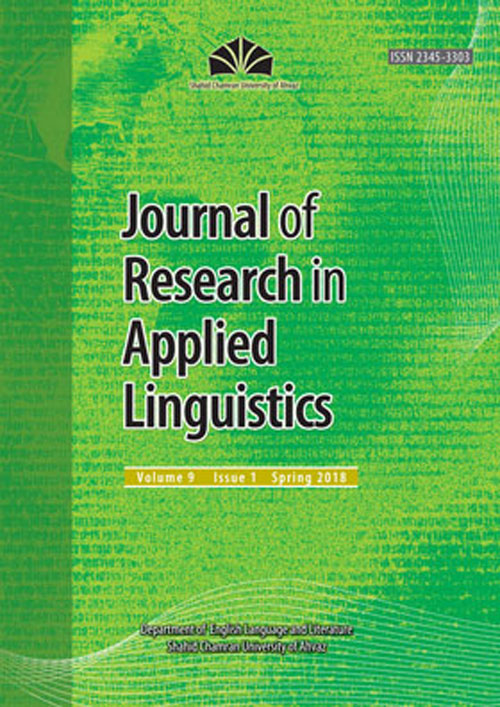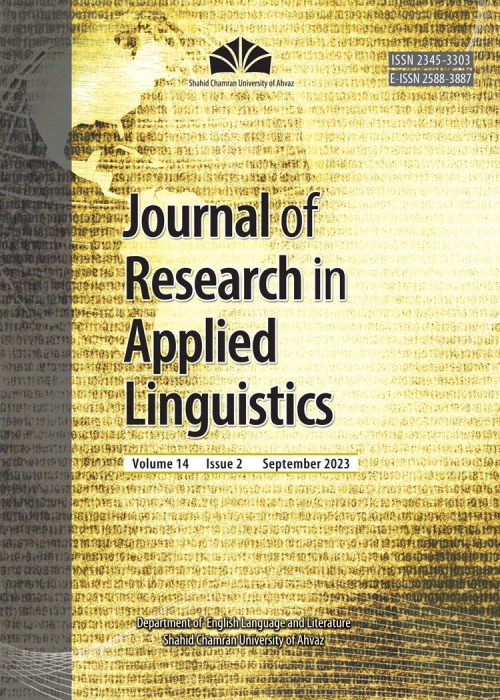فهرست مطالب

Journal of Research in Applied Linguistics
Volume:9 Issue: 1, Spring 2018
- تاریخ انتشار: 1396/12/05
- تعداد عناوین: 7
-
-
Pages 3-27The present study compared the impact of teacher-provided and peer-provided oral assistance in the acquisition of English wh-question forms. Participants were 90 female Iranian EFL learners who constituted the 3 groups of the study: teacherassisted, peer-assisted, and a control group. Participants in the experimental groups received assistance either from the teacher or a peer during task-based performances to make wh-questions, whereas those in the control group performed the same tasks with no assistance. The study took a mixed-methods design. Results from the quantitative pre/posttest analysis showed that both teacher-assisted and peer-assisted groups significantly improved in receptive and productive knowledge of the L2 forms compared to the control group, but no significant difference was observed between the 2 group's degree of language development. Results of the qualitative microgenetic analysis revealed that the peer-assisted group outperformed the teacher-assisted group at the first 2 time points of the experiment. The finding that peer-provided assistance was effective with equal or greater benefits as compared to the teacher-assisted group calls into question the traditional belief that L2 learners are incapable of assisting peers in EFL classrooms.Keywords: Assisted Performance, Teacher, Provided Assistance, Peer, Provided Assistance, Sociocultural Theory, L2 Development
-
Pages 28-56This genre-based study investigated the cross-disciplinary variations in the rhetorical structure of the Discussion sections of 104 applied linguistics and chemistry research articles (RAs), drawing upon Basturkmens (2009, 2012) framework and taking into account the new insights proposed by Bhatia (2004), Shehzad (2008), and Lim (2012). To this end, in addition to collecting quantitative data and conducting frequency and chi-square analyses, a number of semistructured interviews were also conducted with some distinguished chemistry scholars and applied linguistics experts to triangulate the data and get a fuller understanding of the quantitative results. Results of the chi-square analyses revealed significant variations in the way the authors in the 2 disciplines employed moves, steps, and substeps to realize the purpose of the Discussion sections. Findings might prove fruitful for postgraduate students and novice researchers in chemistry and applied linguistics to help them write more effective Discussion section in their research articles.Keywords: Applied Linguistics, Chemistry, Genre analysis, Discussion, Move structure, Research Articles (RAs)
-
Pages 57-82This investigation examined the mixed effects of visual input enhancement, explicit instruction, pushed output, and corrective feedback on noticing and intake of English conjunctive adverbs. Participants included 83 intermediate EFL students enrolled in a grammar and writing course. They were assigned to a control group (n = 22), explicit instruction pushed output explicit corrective feedback group (n = 25), visual input enhancement pushed output implicit corrective feedback group (n = 17), and visual input enhancement enriched input group (n = 19). Design was a pretest, immediate posttest, and delayed posttest type. To assess the participants intake of the targeted structures, 3 tests were developed. One-way ANOVA and a series of post-hoc Scheffe tests were performed on the results. Taken together, the results indicated that all the combined procedures had both positive and lasting effects on the noticing and subsequent intake of the discourse markers (conjunctive adverbs) at issue. Results, further, revealed that the effects of the mixed procedures on the rate and durability of intake of the targeted forms was differential.Keywords: Form, focused instruction (FFI), explicit instruction (EI), visual input enhancement (VIE), Pushed Output (PO), Explicit Corrective Feedback (ECF), implicit corrective feedback (ICF)
-
Pages 83-104Disciplinary studies on metadiscourse in academic texts have come a rather long way (since the 1980s) to afford an awareness of the ways authors strive to signal their insights into their materials as well as their audience. However, few comprehensive corpus-based studies to date have provided a starting point for shaping our understanding of subdisciplinary and paradigmatic diversities within medical contexts in different cultures/languages. For this purpose, 160 research articles (RAs) were picked out from certain databases on medical physics (80) and nursing (80), each group of which was, then, stratified into quantitative (40) and qualitative papers (40) written in English and Persian, and their metadiscourse tokens were compared in terms of type and frequency on the basis of Hyland's (2005) taxonomy. Results indicated a rather cogent homogeneity between the native English writers (NEWs) and Iranian Persian writers (IPWs) in crafting nursing quantitative and qualitative RAs.Keywords: Medical Physics, Nursing, Quantitative Research, qualitative research, English Natives, Persian Natives
-
Pages 105-126The present study was an attempt to refine a qualitatively proposed model of ELT discipline-specific reading strategies to provide a better interpretation of qualitative findings. Hence, in line with the components of the previous model, that is, 6 factors and 32 categories, a 6-hypothetical factor and a 33-item questionnaire were considered in the design of the ELT discipline-specific questionnaire. The questionnaire was piloted with 180 ELT postgraduate learners, and its reliability and the related validities were checked. Finally, the 25-item questionnaire of ELT reading strategies was distributed to 322 ELT postgraduate students. Then, the initial structure of the model was tested using CFA to come up with a final model of ELT reading strategy questionnaire. Results substantiated the initial structure of EFA with 6 factors and 25 items. Consequently, the proposed model of reading strategies can be negotiated with teacher educators. Results can make teacher educators aware of the marginalized voices of ELT postgraduate students. As a result, teacher educators might teach those strategies, when necessary, to student teachers.Keywords: Validation, Preliminary Model, Reading Strategy
-
Pages 127-147WAR as a vehicle and Sport Is War as a conceptual metaphor (CM) seem inadequate to account metaphorically for SPORT. To cater for an inclusive vehicle/CM, we selected WIN and LOSS lexicon from the news coverage of Brazils football team loss to Germany and tested them through the Corpus of Contemporary American English. Then, the data were studied through the 3 stages of metaphor research. In the identification stage, the metaphorical use of the WIN and LOSS lexicon was determined through metaphor identification procedure. In the interpretation stage, the metaphors were revealed to be recontextualized from discourses like war, earthquakes, floods, landslides, and the like. Then, on the basis of a generic source for such discourses, TERRITORY as a vehicle and A Sport Field Is a Territory as a CM were proposed. Finally, in the explanation stage, the ideological implications of the proposed vehicle/CM were argued on the discourse reproduction of Brazils problems.Keywords: Recontextualization, Conceptual Metaphor (CM), Vehicle, Ideology, Territory, War
-
Pages 148-169The present study aimed to document the constraints and limits in applying reflective teaching principles in ELT settings in Iran from the teachers perspective along with solutions and coping strategies to help remove the obstacles. 60 teachers teaching general English at 6 language institutes were selected through convenience sampling. First, the teacher participants filled out a reflectivity questionnaire. 49 were found to be reflective, from among which 25 participated in the semistructured interviews. Inductive analysis procedure resulted in the identification of 3 broad categories of obstacles of reflective teaching including institutional problems, self-directional problems, and problems with reflective teaching principles. In addition, for each category, solutions were offered by the teachers. Findings have implications for policymakers, administrators, and supervisors of language institutes, ELT teachers, and teacher educators to help foster reflectivity.Keywords: Reflective Teaching, ELT, Obstacles, Coping Strategies


